Kaj Halberg - writer & photographer
Travels ‐ Landscapes ‐ Wildlife ‐ People
Borneo 1985: A hike up Gunung Kinabalu
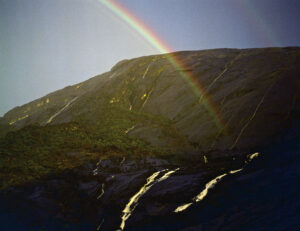
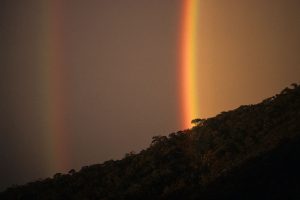
After driving about 100 km, the rain ceases, only to be replaced by huge clouds of dust, raised by trucks driving the opposite way. Naturally, in this dilapidated bus, several of the window panes are missing.
Suddenly the bus starts reeling. A rear tyre has had a puncture, which is not very strange, as most of the tread is missing. The spare tyre, too, is almost devoid of tread, but luckily the crew is able to borrow a spare wheel from a bypassing bus.
Now we can continue our journey, but soon an ominous rattling sound can be heard from beneath the bus. As it turns out, a metal box, which holds the batteries, has fallen off, but, to our immense relief, the batteries are still attached to the wires. The crew members bring the batteries into the bus and re-connect the wires. Frame connection is obtained by unscrewing a bolt in one of the seats, place the wire, and replace the bolt. This arrangement works fine, and we arrive in the town of Ranau without further mishap.
After lunch, the nice bus crew offers to drive us up a side road, free of charge, to the Gunung Kinabalu National Park entrance gate. Here we pay our entry fee, continuing on foot to the Fellowship Hostel, where we are going to stay for three days.
The national park takes its name from the highest mountain on Borneo, Gunung Kinabalu (4094 m). This mountain is usually hidden in clouds, but this afternoon the cloud cover lifts, and the entire beautiful mountain is revealed, surrounded by white wads of cloud, resembling cotton balls.
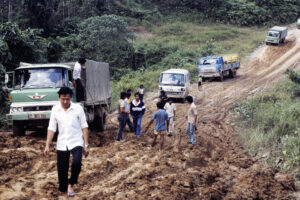
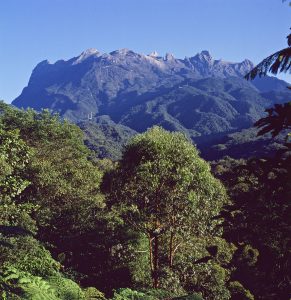
In this forest, sunlight penetrates the dense foliage in beautiful pencils. A large number of trees and bushes grow here, including various oak species (Quercus) and two species of rhododendron, the yellow R. retivenium and the flesh-coloured R. brookeanum. About 27 species of rhododendron occur on Gunung Kinabalu, of which 11 are endemic to the mountain.
Lianas are ubiquitous, including Aeschynanthus speciosus of the gloxinia family (Gesneriaceae), which has beautiful red flowers, also known as ‘lipstick flowers’, due to the shape of the developing buds. On the forest floor, we observe two red-necked keelbacks (Natrix subminiata), well camouflaged among the vegetation. This grass snake is completely harmless.
Birdlife in this forest is abundant, and we observe a large number of bird species, including grey-chinned minivet (Pericrocotus solaris), Whitehead’s broadbill (Calyptomena whiteheadi), black-faced cuckoo-shrike (Coracina novaehollandiae), pied triller (Lalage nigra), and Bornean whistler (Pachycephala hypoxantha). A Bornean green magpie (Cissa jefferyi), which has caught an enormous moth, is struggling with it for quite some time before managing to swallow it.
In the evening, several large-tailed nightjars (Caprimulgus macrurus) fly around lamps at the headquarters, hunting insects.
Mammals are not often observed here, although two species of squirrel are fairly common, the tiny tufted pygmy squirrel (Exilisciurus whiteheadii), which is easily identified by its long, white ear-tufts, and the larger Jentink‘s squirrel (Sundasciurus jentinkii).
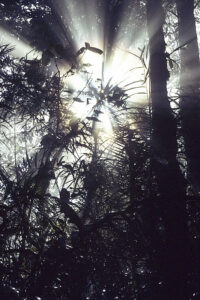
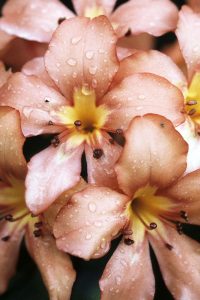
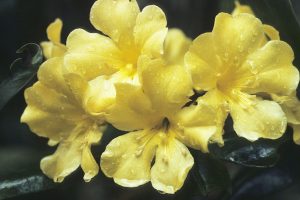
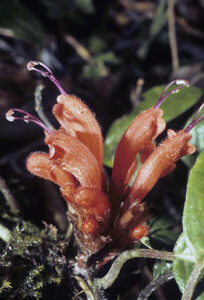
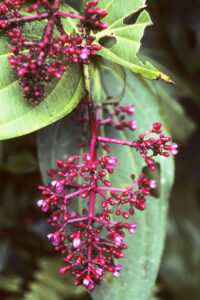
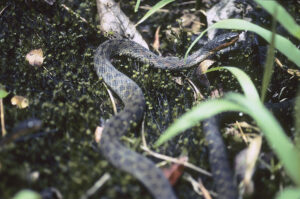
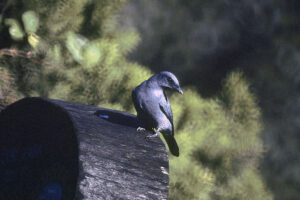
The trail is very steep, so we must often take a break to catch our breath. The slopes along the trail are covered in ferns and mosses, and a balsam species, Impatiens kinabaluensis, is common in more humid areas. Wildlife is quite scarce. We only observe chestnut-crested yuhina (Yuhina everetti) and a single pygmy squirrel.
Along a ridge, at an altitude of c. 2,500 m, the forest is much lower than around the headquarters, and many of the trees are shaped by the sharp wind, which often blows here. The most common species is Leptospermum recurvum, of the myrtle family (Myrtaceae).
We also observe several species of rhododendron, including two species with scarlet flowers, the tall R. buxifolium and R. rugosum, the yellow-flowered R. lowii, and R. ericoides, which has small, red, funnel-shaped flowers and tiny leaves, which resemble those of the European crowberry (Empetrum nigrum).
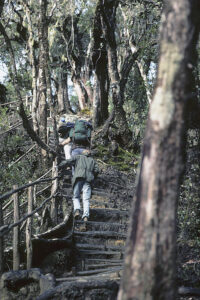
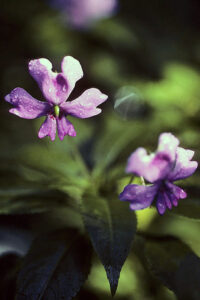
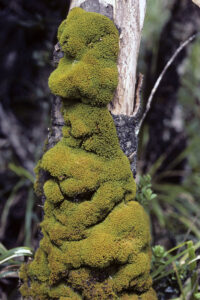
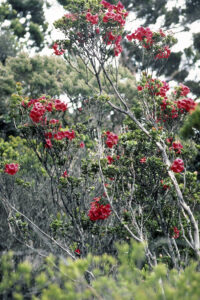
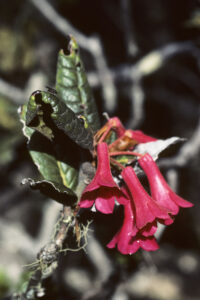
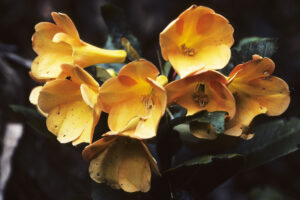

These plants are carnivorous. Each leaf ends in a tendril, which forms a funnel-shaped pitcher. The inside edge along the pitcher is very smooth, often causing insects and other small animals, which walk along the edge, to slide into the pitcher. The pitcher holds a fluid, containing enzymes that dissolve the outer chitin layer of the animals, after which the plant is able to utilize nutrients from the soft inner tissue.
On the inside of the pitcher, along the edge, is a row of stiff, down-pointing hairs, which prevent prey from escaping. Most species of pitcher plants have an umbrella-like structure, covering the pitcher, to prevent the fluid inside from being diluted by rain water. – You may read more about carnivorous plants on the page Plants: Flesh-eating plants.
At this altitude, we also observe several species of orchids and lilies, but only a few are in bloom.
The resting points along the trail are a sad sight, displaying numerous piles of garbage, scattered all over the place. On several occasions, we observe rats of various species, including the endemic summit rat (Rattus baluensis), and also a Bornean mountain squirrel (Dremomys everettii), which are busy investigating these piles in search of edibles.
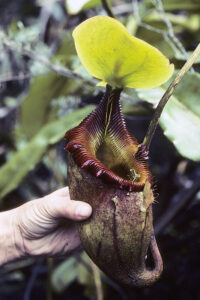
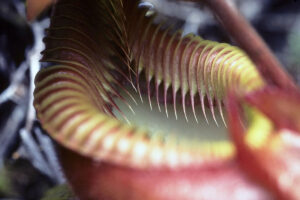
We are now close to Panar Laban, a cluster of huts at an altitude of c. 3,300 m. One of these huts is home to several soldiers, who are busy listening to blaring music, delivered by a transistor radio. The area around the hut is a mess of stinking garbage. We hurry on to another hut to have a rest.
In a swampy area, we observe several flowering plants, including Lowe’s buttercup (Ranunculus lowii) and Bornean cinquefoil (Potentilla borneensis). There is a fantastic view over the surrounding mountains, clouds coming and going. Birdlife in this area is completely dominated by a small, green bird, the mountain blackeye (Chlorocharis emiliae), whose melodious song we enjoy far more than the soldiers’ music.
The last bit of the trail before the hut at Sayat-Sayat (sayat is the local name of Leptospermum) is very steep indeed, and we must cling to ropes, tied to metal rings, which have been attached to the naked rock wall. Flowers in this area are small and humble, including Bornean eyebright (Euphrasia borneensis) and mountain trachymene (Trachymene saniculifolia).
The last 100 m before the hut is a true torment for me. As it turns out, the hut is very small, with just 10 beds, and a tiny kitchen, containing a few pots and pans, and two kerosene stoves. My companions commence cooking our evening meal: rice with yellow peas and Swedish meatballs. However, I have absolutely no appetite and creep into my sleeping bag without eating.
It is cold, and the door cannot be closed completely, causing a draught, which add to the cold. Despite being exhausted, I’m not able to fall asleep. Throughout the night, rats are pattering about, and suddenly Niels starts up, maintaining that he saw a huge orangutan, weeping tears of kerosene down the mountain side.
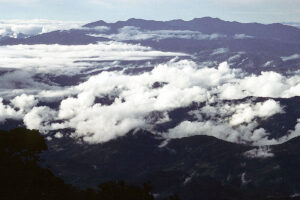
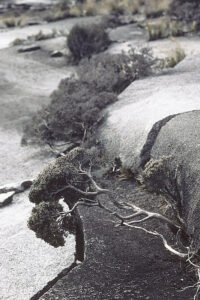
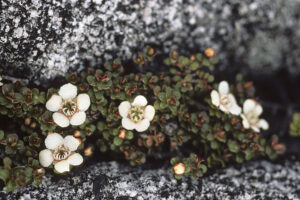
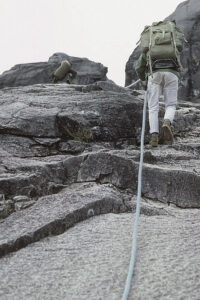
We awake our guide, who starts up, saying: ”Go up now?”
In fact, it was his job to awake us, not the other way around!
It is rather cloudy this morning, and as we gain in altitude, the cloud cover thickens. For me, walking up this steep section of the trail is very tough indeed. I am exhausted, having had almost no food for about 20 hours.
At dawn, we pass clusters of rocks, bearing vivid names like Donkey’s Ears, Ugly Sister, and St. John’s Peak. We are now close to the peak proper, and I’m near a breakdown. A dense fog has enveloped the peak, where a small group of freezing people huddle together.
Niels is already here, almost buried in his sleeping bag, and when we join him, he produces a bottle of homemade apple liqueur from his backpack, grinning widely. A few swigs bring a welcome heat into our freezing bodies.
As we are sitting here, who appear out of the fog? Slow and steady! A hearty reunion, followed by more apple liqueur swigs.
For several hours, we wait for the fog to lift, but in vain. A few times, we are able to glimpse a few weirdly shaped rocks, distorted by the fog, far away. Finally, we give up and start our hike back towards Sayat-Sayat, where we take a short rest before heading out for the huts at Panar Laban.
Our guide urges us to hurry up, as he is of the opinion that it will soon begin to rain. We have hardly reached our goal, before heavy rain starts falling, continuing throughout the night.
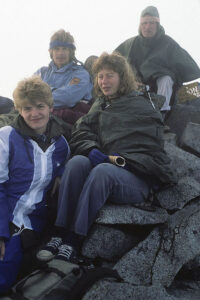
Over the forest, we can admire the most beautiful double rainbow, glowing through an almost unreal reddish light – a sight which is by far worth all our efforts.

